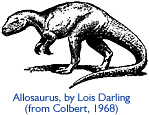Museum of Riverside

Our Allosaurus and the Natural History Collections

We shared some dinosaur love! In 2023, we donated our cast reproduction of an allosaurus skeleton to the University of California, Riverside, Earth & Planetary Sciences Museum. Because the allosaurus never lived in Riverside, and the Museum of Riverside's mission is focused on Riverside, we knew the skeleton cast would fit with the Earth & Planetary Sciences Museum's own mission. Check in with them to learn when the allosaurus might be reassembled and put on view!
Geology and Earth Sciences
The Museum’s geological and earth sciences holdings consist of approximately 3,500 specimens including Southern California rocks, minerals, and fossils. The geology collections include specimens from the Crestmore Quarry contact metamorphic complex of rare minerals. One of the largest donations to the collection was assembled by science educator J. W. Eggleston and came from Riverside City College in the early 1950s. The S. M. Purple Fossil Collection includes type specimens of giant prehistoric California sharks.Life Sciences
Over 450 zoology specimens depict the wildlife of the Riverside region including: local species of mammals, reptiles, amphibians, bird skins, eggs, and nests. Approximately 3,000 insect specimens document regional sites of scientific significance (as in a series of voucher insect specimens collected as part of ecological studies of the Deep Canyon facility of the University of California Natural Land and Water Reserve System), in addition to reflecting the role played by the University of California, Riverside, in research into agricultural pest biocontrol. The collections feature approximately 1,000 dry specimens of molluscs, crustaceans, and other marine invertebrates have been contributed over the years by amateur collectors from the community.The Clark Herbarium
The Clark Herbarium is a reference "library" representing the plant diversity and changes of Southern California. With almost 10,000 specimens, the Clark Herbarium includes dry botanical mounts, most of which were collected from the Riverside region and surrounding counties by J. C. Roos and other botanists between 1920 and 1960. A collection of lichens and fungi was assembled during the 1930s by Edmund C. Jaeger, and was later donated to the Museum during his tenure as Curator of Plants. New specimens are regularly added to the herbarium. All these materials now represent an important database describing the distribution of native plant species in the southwestern U.S., which is now a vastly altered environmental setting.The state of California possesses a greater variety of plant species than just about any other comparable geographic area outside of a tropical rainforest. Of this diversity, the Riverside region is endowed with a considerable share, in large part due to the enormous variation in topography and climate that occurs over a relatively small horizontal distance. "As the crow flies," it is possible, in fewer than 10 miles, to travel from below-sea-level saltbush desert to sub-alpine forest communities. As the human population of Southern California continues to grow, some of the Riverside region’s most distinctive plant communities, such as the coastal sage scrub and riparian woodlands, are among the most endangered in the state. The Museum established its botanical section in 1954. During the early years, renowned naturalist Edmund C. Jaeger became the museum's Curator of Plants. Facilities for housing a plant collection grew slowly until the late 1970s, when Dr. John C. Roos of Loma Linda offered his personal collection, which included material collected by his father, Alfred Roos, Jaeger, and many others. With specimens collected from the 1930s to the 1970s, the Roos collection emphasizes species from Riverside and surrounding counties in Southern California, plus portions of central California, western Nevada, and northwest Mexico. The Roos specimens became the core Clark Herbarium holdings. The Clark Herbarium is named after Dr. Charles F. and Wilhelmina Husser Clark whose 1949 bequest provided for the establishment of the botanical section.
More Nature Links
Stay Connected
Main Museum
|
Address: 3580 Mission Inn Avenue Riverside, CA 92501 Phone: (951) 826-5273 Hours |
|
| Closed for Innovation | |
Heritage House
|
Address: 8193 Magnolia Ave. Riverside, CA 92504 Hours Open Sept (1st weekend after labor day) to June. |
|
| Monday - Thursday | Closed |
| Friday - Sunday | Open at 12:00 pm - Last Tour at 3:15 pm |
| Closed Major Holidays | |
Harada House
| Not Open to the Public |


